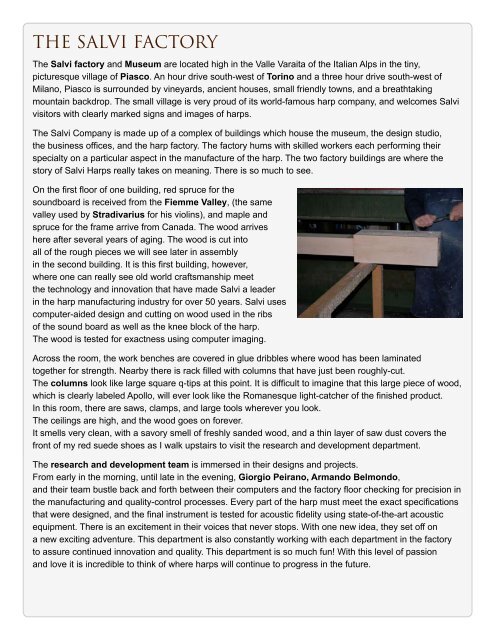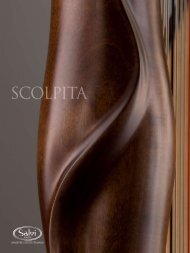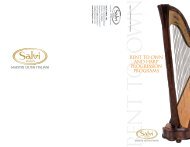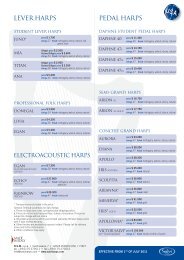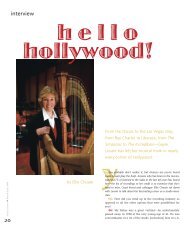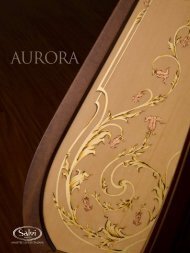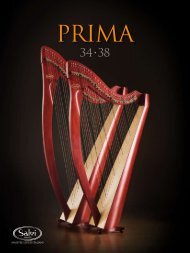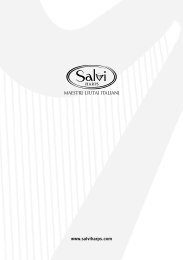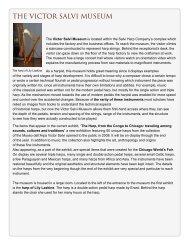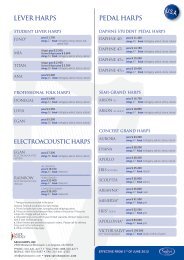You also want an ePaper? Increase the reach of your titles
YUMPU automatically turns print PDFs into web optimized ePapers that Google loves.
The <strong>Salvi</strong> Factory<br />
The <strong>Salvi</strong> factory and Museum are located high in the Valle Varaita of the Italian Alps in the tiny,<br />
picturesque village of Piasco. An hour drive south-west of Torino and a three hour drive south-west of<br />
Milano, Piasco is surrounded by vineyards, ancient houses, small friendly towns, and a breathtaking<br />
mountain backdrop. The small village is very proud of its world-famous harp company, and welcomes <strong>Salvi</strong><br />
visitors with clearly marked signs and images of harps.<br />
The <strong>Salvi</strong> Company is made up of a complex of buildings which house the museum, the design studio,<br />
the business offices, and the harp factory. The factory hums with skilled workers each performing their<br />
specialty on a particular aspect in the manufacture of the harp. The two factory buildings are where the<br />
story of <strong>Salvi</strong> <strong>Harps</strong> really takes on meaning. There is so much to see.<br />
On the first floor of one building, red spruce for the<br />
soundboard is received from the Fiemme Valley, (the same<br />
valley used by Stradivarius for his violins), and maple and<br />
spruce for the frame arrive from Canada. The wood arrives<br />
here after several years of aging. The wood is cut into<br />
all of the rough pieces we will see later in assembly<br />
in the second building. It is this first building, however,<br />
where one can really see old world craftsmanship meet<br />
the technology and innovation that have made <strong>Salvi</strong> a leader<br />
in the harp manufacturing industry for over 50 years. <strong>Salvi</strong> uses<br />
computer-aided design and cutting on wood used in the ribs<br />
of the sound board as well as the knee block of the harp.<br />
The wood is tested for exactness using computer imaging.<br />
Across the room, the work benches are covered in glue dribbles where wood has been laminated<br />
together for strength. Nearby there is rack filled with columns that have just been roughly-cut.<br />
The columns look like large square q-tips at this point. It is difficult to imagine that this large piece of wood,<br />
which is clearly labeled Apollo, will ever look like the Romanesque light-catcher of the finished product.<br />
In this room, there are saws, clamps, and large tools wherever you look.<br />
The ceilings are high, and the wood goes on forever.<br />
It smells very clean, with a savory smell of freshly sanded wood, and a thin layer of saw dust covers the<br />
front of my red suede shoes as I walk upstairs to visit the research and development department.<br />
The research and development team is immersed in their designs and projects.<br />
From early in the morning, until late in the evening, Giorgio Peirano, Armando Belmondo,<br />
and their team bustle back and forth between their computers and the factory floor checking for precision in<br />
the manufacturing and quality-control processes. Every part of the harp must meet the exact specifications<br />
that were designed, and the final instrument is tested for acoustic fidelity using state-of-the-art acoustic<br />
equipment. There is an excitement in their voices that never stops. With one new idea, they set off on<br />
a new exciting adventure. This department is also constantly working with each department in the factory<br />
to assure continued innovation and quality. This department is so much fun! With this level of passion<br />
and love it is incredible to think of where harps will continue to progress in the future.
From the research and development department, we walk<br />
down a large hall past the central break area, which of<br />
course in Italy, is a giant espresso vending machine (makes<br />
great espresso).<br />
The door on the other side of the hallway opens to the<br />
gilding and painting department. Three women inside this<br />
room carefully apply delicate sheets of gold to two columns<br />
and a base. There is no hand painting happening today,<br />
but this would also occur here. The parts get several layers<br />
of gold leaf before they are completed and polished. The<br />
women who work in this room are very friendly and happy,<br />
and they seem to love the camera.<br />
Next door to the gilding department is the harp testing room. It is here, where all harps come which have<br />
been completed. The harpist plays each harp and listens for any buzzes, pedal noise, or action movement.<br />
She sends back any harp that needs adjusting. Her words are very important to both the production<br />
department and the research and development department. She takes great pride in assuring the harps<br />
she tests are “just right”. Inside her room is the new Iris.<br />
The Iris has been updated with a new soundboard which creates a beautiful tone.<br />
I have been excited for months to try it. The harp sounds gorgeous. The sound is very full, not too rich<br />
and not too bright in the top end. The notes have clarity and yet the sound carries extremely well. This harp<br />
is incredible!<br />
Next door to the harp testing room is the final production department where harps are finally getting their<br />
strings, and pedal harps are fitted with actions. Next, further down the hall, harps receive regulation.<br />
Here, five regulators each have their own rooms, and they are hard at work. The rooms are all extremely<br />
efficient and clean. The people who work here are always joking and have great big smiles and laughs.<br />
In the midst of all of this activity, in the large center of the room there are harps being boxed for shipping,<br />
and also warehouse shelves full of interesting things: sheet music, CDs, posters, and so much more.<br />
On the second floor of this building are offices for everyone from accounting to sales, to the managing<br />
director. The offices are always busy. People speak many languages as they plan events, sell harps, order<br />
parts, or arrange for shipments.<br />
In the second building, we see how the harp is built from the beginning. The harp is not just one piece<br />
of wood, but many, many different pieces and processes that come together to make each instrument.<br />
Here wood is cut, aged for several years, carved, assembled, finished, gilded and regulated over countless<br />
hours of hands-on labor. There is a great feeling of camaraderie between the craftsmen of all ages<br />
who displayed tremendous pride and passion in their work. It isn’t big machines that form the harp,<br />
but individual people, often several from the same family, who<br />
shape and create the various pieces.<br />
At one workbench, it is a site to see the Arianna made.<br />
The artisan works on very small sections a time. With a look<br />
of intense concentration, using both hands to steady his inlay tool,<br />
he carefully pieces together the beautiful different kinds of wood into<br />
their characteristic patterns. He is so proud to share moments on<br />
camera and lets the lens catch a glimpse of the magic.
The next workspace belongs to a young man who is carving<br />
an Iris base.<br />
Carved completely using hand tools, shaving by shaving the<br />
wood is cut away to reveal beautiful leaves and flowers. In his<br />
hands the pattern gradually emerges becoming intricate flowers<br />
and pattern.<br />
The carved wood eventually will be covered in pure gold leaf.<br />
Just around the corner, his mother, covered in sanding dust,<br />
smoothes out the inside of a column preparing the harp for<br />
the pedal mechanism. She likes to speak what <strong>Salvi</strong> means to her. She works every day with her own son<br />
and daughter. <strong>Salvi</strong> is truly a family career.<br />
Closer to the back of the room, there are rows of lever harps waiting<br />
to go through the final finishing before they go to assembly.<br />
There are desks for sanding the outside of the body and desks<br />
for applying stain. There is also a large, clean spray booth, about<br />
the size of a carwash, where layers of clear polyurethane finish are<br />
applied, over and over to each harp, giving them a strong protective,<br />
beautiful finish. The pieces are hung from a track in the ceiling<br />
and are moved along this track to the drying area.<br />
The spray booth is the domain of a single person who is responsible<br />
for this phase of the process.<br />
As you leave the finishing department, you start to see harps really taking shape. When you enter the<br />
room, there are three long aisles filled with separate harp parts. In the last aisle, the small pieces are<br />
literally coming together into instruments. No longer just a crown or a neck, piece by piece, the harps are<br />
covered in clamps and measuring tools larger than the harps themselves. At the end of the aisle, one<br />
craftsman very carefully drills holes through the base readying this part for the rods and pedal assembly.<br />
At the other end of the aisle, a different craftsman is putting tuning pins on a Livia as she measures the<br />
lengths very carefully.<br />
Across the complex from the factory is the Museo dell’Arpa “Victor <strong>Salvi</strong>.” This is the first museum<br />
exclusively for the harp world. Located on the second floor of one of the factory buildings, the room is filled<br />
with harps of all shapes and histories. The collection houses early instruments, some carved into animal<br />
shapes, along with showing the development of the mechanism to its present form. There are harps of<br />
some of the seminal artists who contributed great impact to the artistry of harp evolution. We will come<br />
back to the museum in the next section of the newsletter.<br />
The <strong>Salvi</strong> Concert Hall is located in a large room next<br />
to the museum. This room is also used to show an<br />
informative movie which chronicles the history of <strong>Salvi</strong>,<br />
and explains the process of harp manufacture.<br />
Downstairs from the concert hall are two huge rooms that<br />
make up the <strong>Salvi</strong> showroom. When the doors first open<br />
to the showroom, a Victor <strong>Salvi</strong> 50th Anniversary harp<br />
glistens in the fine beam of golden sunlight. There are two<br />
gorgeous Apollonias, along with the entire collection of harps
made by <strong>Salvi</strong>. Every harp calls out to be played. Moving through a second door finds even more harps<br />
on display. Set in a beautiful room with warm wood, floors, glittering chandeliers, and sumptuous blue<br />
curtains, this is truly a harpist’s heaven. Imagine two large, beautiful rooms filled with the most beautiful<br />
harps in the world.<br />
Just a five minute drive from the factory, up a very steep windy hill, is the Hotel Castello Rosso.<br />
This Hotel is an old castle which has been renovated into a very comfortable bed and breakfast hotel.<br />
It sits on many acres of beautifully landscaped land that winds around the top of the hill and provides<br />
a very good view of the mountains, the village, and the countryside. The hotel is perfectly romantic,<br />
and was the perfect place to stay while visiting where our beautiful harps were born.<br />
For a guided video tour of the factory, go to:<br />
<strong>Salvi</strong> <strong>Harps</strong> Factory Tour<br />
(http://www.youtube.com/watchv=ko1WqYrEZEk)<br />
You can also see some parts of the factory on Catrin Finch’s History of the Harp Series, also on You Tube:<br />
The History of the Harp - Part 1<br />
(http://www.youtube.com/watchv=WPylNyV3-4E)<br />
The History of the Harp - Part 2<br />
(http://www.youtube.com/watchv=6zw9v6px9x4&feature=related)<br />
The History of the Harp - Part 3<br />
(http://www.youtube.com/watchv=pQSo9sHaK2g&feature=related)<br />
The History of the Harp - Part 4<br />
(http://www.youtube.com/watchv=5SZbXJB8ze8&feature=related)<br />
The History of the Harp - Part 5<br />
(http://www.youtube.com/watchv=RJu2U3IogWg&feature=related)<br />
The History of the Harp - Part 6<br />
(http://www.youtube.com/watchv=Qz-68d2P8Gc&feature=related)<br />
The new <strong>Salvi</strong> <strong>Harps</strong> website is now online!<br />
In addition to the American <strong>Salvi</strong> <strong>Harps</strong> website (www.salviharpsinc.com) <strong>Salvi</strong> Italy has a beautiful new website.<br />
www.salviharps.com


